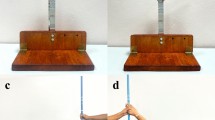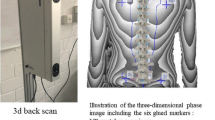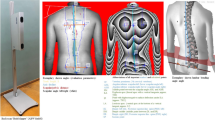Abstract
The Q-angle has been studied among the adult Caucasian population with the establishment of reference values. Scientists are beginning to accept the concept of different human races. Physical variability exists between various African ethnic groups and Caucasians as exemplified by differences in anatomic features such as a flat nose compared with a pointed nose, wide rather than narrow faces, and straight rather than curly hair. Therefore, we cannot assume the same Q-angle values will be applicable to Africans and Caucasians. We established a baseline reference value for normal Q-angles among asymptomatic Nigerian adults. The Q-angles of the left and right knees were measured using a goniometer in 477 Nigerian adults (354 males; 123 females) in the supine and standing positions. The mean Q-angles for men were 10.7° ± 2.2° in the supine position and 12.3° ± 2.2° in the standing position in the right knee. The left knee Q-angles in men were 10.5° ± 2.6° in the supine position and 11.7° ± 2.8° in the standing position. In women, the mean Q-angles for the right knee were 21° ± 4.8° in the supine position and 22.8° ± 4.7° in the standing position. The mean Q-angles for the left knee in women were 20.9° ± 4.6° in the supine position and 22.7° ± 4.6° in the standing position. We observed a difference in Q-angles in the supine and standing positions for all participants. The Q-angle in adult Nigerian men is comparable to that of adult Caucasian men, but the Q-angle of Nigerian women is greater than that of their Caucasian counterparts.
Similar content being viewed by others
References
Aglietti P, Insall JN, Cerulli G. Patellar pain and incongruence. I: Measurements of incongruence. Clin Orthop Relat Res. 1983;176:217–224.
Blake CR, Lai WW, Edward DP. Racial and ethnic differences in ocular anatomy. Int Ophthalmol Clin. 2003;43:9–25.
Byl T, Cole JA, Livingston LA. What determines the magnitude of the Q angle? A preliminary study of selected skeletal and muscular measures. J Sport Rehab. 2000;9:26–34.
Clark LT. Anatomic substrate differences between black and white victims of sudden cardiac death: hypertension, coronary artery disease, or both? Clin Cardiol. 1989;12(suppl 4):IV13–17.
Hahn T, Foldspang A. The Q angle and sport. Scand J Med Sci Sports. 1997;7:43–48.
Handa VL, Lockhart ME, Fielding JR, Bradley CS, Brubaker L, Cundiff GW, Ye W, Richter HE. Racial differences in pelvic anatomy by magnetic resonance imaging. Obstet Gynecol. 2008;111:914–920.
Herrington L, Nester C. Q-angle undervalued? The relationship between Q-angle and medio-lateral position of the patella. Clin Biomech (Bristol, Avon). 2004;19:1070–1073.
Holmes SW Jr, Clancy WG Jr. Clinical classification of patellofemoral pain and dysfunction. J Orthop Sports Phys Ther. 1998;28:299–306.
Horton MG, Hall TL. Quadriceps femoris muscle angle: normal values and relationships with gender and selected skeletal measures. Phys Ther. 1989;69:897–901.
Hungerford DS, Barry M. Biomechanics of the patellofemoral joint. Clin Orthop Relat Res. 1979;144:9–15.
Hvid I, Andersen LB, Schmidt H. Chondromalacia patellae: the relation to abnormal patellofemoral joint mechanics. Acta Orthop Scand. 1981;52:661–666.
Leroi AM. A family tree in every gene. The New York Times. March 14, 2005.
Livingston LA. The quadriceps angle: a review of the literature. J Orthop Sports Phys Ther. 1998;28:105–109.
Manual of Orthopedic Surgery. Park Ridge, IL: American Orthopaedic Association; 1972.
McConnell J. The management of chondromalacia patellae: a long-term solution. Aust J Physiotherapy. 1986;32:215–223.
Mizuno Y, Kumagai M, Mattessich SM, Elias JJ, Ramrattan N, Cosgarea AJ, Chao EY. Q-angle influences tibiofemoral and patellofemoral kinematics. J Orthop Res. 2001;19:834–840.
Ogunlade SO, Alonge TO, Omololu AB, Adekolujo OS. Clinical spectrum of large joint osteoarthritis in Ibadan, Nigeria. Eur J Sci Res. 2005;11:116–122.
Omololu B, Tella A, Ogunlade SO, Adeyemo AA, Adebisi A, Alonge TO, Salawu SA, Akinpelu AO. Normal values of knee angle, intercondylar and intermalleolar distances in Nigerian children. West Afr J Med. 2003;22:301–304.
Outerbridge RE. Further studies on the etiology of chondromalacia patellae. J Bone Joint Surg Br. 1964;46:179–190.
Sanfridsson J, Arnbjornsson A, Friden T, Ryd L, Svahn G, Jonsson K. Femorotibial rotation and the Q-angle related to the dislocating patella. Acta Radiol. 2001;42:218–224.
Simmons K. The Bush Foundation study of child growth and development. Monogr Soc Res Child Dev. 1944;9:1–87.
Wilson T, Kitsell F. Is the Q-angle an absolute or variable measure? Physiotherapy. 2002;88:296–302.
Woodland LH, Francis RS. Parameters and comparisons of the quadriceps angle of college-aged men and women in the supine and standing positions. Am J Sports Med. 1992;20:208–211.
Author information
Authors and Affiliations
Corresponding author
Additional information
Each author certifies that he or she has no commercial associations (eg, consultancies, stock ownership, equity interest, patent/licensing arrangements, etc) that might pose a conflict of interest in connection with the submitted article.
Each author certifies that his or her institution has approved the human protocol for this investigation, that all investigations were conducted in conformity with ethical principles of research, and that informed consent for participation in the study was obtained.
About this article
Cite this article
Omololu, B.B., Ogunlade, O.S. & Gopaldasani, V.K. Normal Q-angle in an Adult Nigerian Population. Clin Orthop Relat Res 467, 2073–2076 (2009). https://doi.org/10.1007/s11999-008-0637-1
Received:
Accepted:
Published:
Issue Date:
DOI: https://doi.org/10.1007/s11999-008-0637-1




